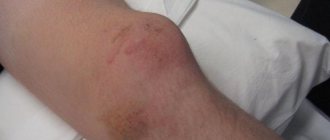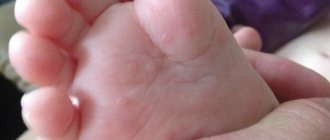Types of fractures
First of all, two types of fractures are distinguished; initially, the doctor pays attention to this:
- open - there is a violation of the integrity of the skin by parts of the broken bone, possibly the presence of a small wound, destruction of soft tissues with penetration of dirt may be observed, bleeding, both small and intense, is possible;
- closed - there is a bone fracture, which can be diagnosed using an x-ray, the skin remains intact.
The following types of fractures are also distinguished:
- compressive - one bone exerts strong pressure on another, particularly under load;
- a fracture with displacement of the arm in a child - bones move, a large area of damage occurs, nerve endings and large vessels may be affected;
- double - a fracture of the arm in two places at once, for example, the ulna and also the radius bone are broken at the same time.
The special specificity of children is based on the characteristics of the musculoskeletal system:
- the outer shell (periosteum) is much better supplied with blood and is denser than that of an adult;
- the bones still have growth zones;
- the presence of a large number of organic substances in the bone tissues of toddlers;
- callus forms much faster.
You need to know that in children it takes less time for fractures to heal than in adults.
However, the possibility of consequences should be taken into account:
- slowing down, then completely stopping bone growth ahead of schedule;
- shortening of a previously fractured limb;
- formation of curvatures.
You should know that children can experience spontaneous fractures, even from minor blows. Their development is caused by a deficiency of calcium in the body, a congenital disorder of mineral metabolism or acquired, which leads to the development of osteoporosis, as a result of which increased bone fragility.
https://youtu.be/w5vEbaOL3bQ
Therapeutic measures
Treatment of a fracture in a child can be successfully carried out at home if there are no complications. In case of a closed injury with minimal or no displacement, the doctor puts a plaster cast on the child’s limb, prescribes medications to relieve swelling and relieve pain, and releases him for outpatient treatment. A child may be hospitalized if:
- the injury is open;
- there is a large displacement of fragments;
- damaged tendons, blood vessels, nerve endings;
- there is major bleeding;
- the wound became infected;
- there are associated injuries, for example, a burn;
- the fracture line runs inside the joint;
- the child needs to have surgery.
In conservative treatment, plaster is applied so that the outer phalanges of the fingers remain open; their color can be seen if problems with blood circulation arise. If the child is being treated at home, the parents should take him to the attending physician every week for an examination until the bone heals completely. How long to wear a plaster splint depends on the type of fracture, its location, the child's age and susceptibility to treatment, but generally this period lasts one or two months.
Surgery may also be prescribed to treat a broken arm. The operation is performed if:
- Closed reduction of fragments is impossible;
- There is a risk of improper bone healing;
- The fragments pinched the nerve;
- There are many fragments present.
As a rule, the operation is performed only after the complete elimination of swelling, but it can also be done on an emergency basis if there is a need to stitch together large vessels and pull out individual bone segments. In a comminuted fracture, the bone is held together with a plate and screws, sometimes with knitting needles, which are removed a year after the injury during reoperation.
What to do if you had to deal with such a nuisance as a broken arm in a child? Children are active and restless creatures; it is difficult to force a child to sit quietly in one place. Outdoor games, sports - all this has a positive effect on the child’s body, strengthening the muscle corset and training coordination and endurance. Activity is necessary for a child to develop harmoniously; however, at the same time, it is fraught with danger. Children are careless and do not think about the consequences of their actions.
A fracture of the arm can occur even in the most trivial cases - a fall from one’s own height, while playing on the playground, running or walking, or even simply due to careless movement. According to statistics, children break their upper limbs twice as often as their lower limbs. The most vulnerable places that suffer from fractures in the first place are the elbow joint, the radius, and the bones of the forearm. In this article we will look at the causes of fractures, their main types, as well as the necessary first aid that should be provided to a child with a suspected fracture.
Trauma at school or kindergarten
If a child breaks his arm while in a government institution, parents should follow these steps:
- first of all, you need to examine the baby, clarify what first aid measures were provided to him;
- Next, you need to request an incident report, which should include the following points: the time when the fracture occurred; what contributed to this incident; whose fault this happened; Full name of the educator or teacher in whose lesson the incident occurred;
- Visit to the emergency room; after professional assistance provided to the child, do not forget to ask for the appropriate certificate;
- contact the administration of the school or kindergarten to resolve the situation.
Sick leave and insurance
Many parents wonder whether they provide insurance for this type of injury? The answer here is ambiguous. In fact, if you have taken care in advance of purchasing an accident insurance policy for your baby, then it will be present. However, here it is necessary to take into account that a certain amount will be paid, which does not always cover all expenses for the treatment and recovery period. This is due to the fact that children have a high percentage of injuries and insurers know this very well; they will not work to their detriment.
Regular health insurance may not provide such services free of charge.
The second question that most often worries parents in such a situation: will they give their mother sick leave? Here, too, not everything is so simple. In fact, you receive paid sick leave if a child under the age of 15 requires outpatient or inpatient treatment with the mandatory presence of a relative, that is, the baby needs careful care. And there are still some points:
- if the child is under seven years old, sick leave is given until complete recovery;
- from seven to fifteen years – up to 15 days;
- over fifteen years – three days (only in case of outpatient treatment).
It turns out that if you receive a closed fracture without displacement, you may not receive sick leave, or you may receive it for three days. But with an open one or such, when surgery was required - for a long period, and if the child is less than seven years old - until complete recovery. In fact, everything is determined by each specific case. And the duration of sick leave can be increased by the decision of the medical commission.
Causes
A child in the kindergarten broke his arm while playing on the playground; the injury occurred at home. What factors provoke this phenomenon:
- the baby fell on his hand from a height, for example, jumping from a slide;
- during sports exercises under heavy load;
- due to the fall of a heavy object on the toddler’s hand;
- The baby has osteoporosis, the bones are too brittle.
You should also not forget about fractures received as a result of a traffic accident.
Main features
If a child has a broken arm, symptoms may manifest as follows:
- strong and sharp pain at the site of suspected injury;
- puffiness and swelling;
- the presence of a special crunch resulting from the friction of two parts from a broken bone;
- limb deformation is possible.
These are the main signs; there may also be additional ones:
- inability to move the joint;
- the intensity of pain increases if you change the position of the hand;
- the appearance of cold sticky sweat;
- the occurrence of hematomas at the site of injury;
- the skin turns pale and you may feel dizzy;
- breathing and heart rate increases;
- if there is an open fracture, there is bleeding of varying intensity depending on the degree of damage.
If there are even minimal signs of a fracture, you should immediately contact a traumatologist. To make a correct diagnosis, you cannot do without an x-ray.
Diagnostics
To determine the presence of a fracture, the following steps will be taken:
- examination of the patient, questioning of complaints, finding out the reasons for the incident;
- the presence of the following symptoms is established: hematomas, deformities, movement disorders, swelling and soreness, crepitus;
- the general condition of the child is assessed, special attention is paid to the head, abdomen, neck, chest, the presence of reflexes and the level of consciousness are assessed;
- Radiography is prescribed in two projections. This is necessary to determine the nature of the injuries, the formation of fragments, and reveals the exact location of the fracture.
If necessary, the following are also prescribed:
- MRI;
- ultrasound diagnostics;
- consultation of narrow specialists.
We provide first aid
In case of a fracture, medical intervention cannot be avoided. Never set a bone yourself. The first task of parents is to calm the baby, immobilize him and then call the doctors.
Let's look at general measures to provide first aid.
- Using available means, immobilize the injured limb. For this purpose, cardboard, plywood, a ski pole, or newspaper folded in several layers will suit you.
- Now you need to fix the hand, it is advisable to do this with bandages or pieces of fabric. Parents should take care of the immobility of the joints between which the fracture site is located. It is recommended to apply cold.
- If you have ever broken your arm, then you probably know how much pain is accompanied by this injury. The baby cannot endure it, and he doesn’t need to. Therefore, it is important to take care of taking analgesics. For children, you can use drugs based on paracetamol or ibuprofen. For example, Nurofen has proven itself well.
- If a child has an open fracture, then first of all it is necessary to treat the torn area of skin. For this purpose, it is necessary to use any available antiseptics, for example, hydrogen peroxide. After treatment, a sterile napkin is applied to the affected area, and only then the limb is fixed.
- If there is severe bleeding due to an open fracture, then it is necessary to apply a tourniquet above the site of injury to the skin and immediately call an ambulance.
- If you notice that the baby has a traumatic shock, bring a piece of cotton wool coated with ammonia (literally a couple of drops) to his nose (at a distance of seven cm). This will help bring him to his senses.
First aid
What to do if you suspect your baby has a broken arm? There is no way around this without going to a medical facility. But until this moment, try to alleviate the child’s condition using the following methods:
- Immobilize the injured limb by applying a splint using improvised means - sticks, hard cardboard or a ruler.
- Secure the entire limb using pieces of fabric or bandages.
- Apply cold, this will relieve swelling and soothe the pain a little.
- Give your child pain medication.
- In case of an open fracture, the wound should be treated with an antiseptic solution, and then a sterile napkin should be placed on top.
- If arterial bleeding is observed (bright scarlet blood, actively flowing in a pulsating stream), a tourniquet should be applied above the fracture site. If there is bleeding from a vein, apply a tourniquet below the injured area. In both cases, you should immediately take the child to a medical facility, or call a doctor or ambulance to your home.
If the child was injured outside the home - at school or kindergarten, first of all examine the child, find out what first aid actions were taken by the teacher or educator, as well as what medications were given to the child.
Treatment
First of all, the doctor will numb the baby and put a cast on the fracture site, but only after taking an x-ray and confirming the alleged diagnosis.
In most cases, hospitalization for a broken arm is not necessary. However, there are situations when it is needed:
- severe blood loss;
- there is damage to tendons and nerve fibers;
- with an open fracture, an infection has entered the wound and continues to spread;
- during a fracture, the bone is crushed into several fragments that need to be removed surgically;
- bone injury is accompanied by a severe burn;
- the need for surgical intervention.
Parents should understand that treatment can be both surgical and conservative.
- Conservative treatment is prescribed for a closed fracture, in the presence of only two bone fragments, and is accompanied by:
- pain relief with analgesics, for example, novocaine;
- the use of drugs to relieve swelling;
- applying plaster;
- tying the arm with an immobilizing bandage;
- the doctor must take care of oxygen access to the hand and ensure that the functioning of the nerve tissues is not disrupted.
- Surgical intervention is necessary for:
- damage to nerves and large vessels;
- repeated displacement of fragments;
- open injuries;
- inability to correctly compare the fragments;
- instability of bone fragments.
It must be taken into account that surgery increases the risk of damage to the germ cells of bone growth zones.
The surgery takes place under general anesthesia. Anatomical alignment of bone fragments is carried out for epiphyseal and displaced articular fractures. Fixation is performed using a Kirschner wire, which is removed after complete fusion of the bone.
For any type of treatment, the following therapy is prescribed:
- taking analgesics;
- anti-inflammatory drugs;
- drugs that increase the intensity of bone fusion;
- medications with chondroitin and calcium;
- immunomodulators;
- vitamin therapy.
For children, plaster casts are used instead of circular plaster casts.
The plaster is removed after complete fusion of the bones. This may take a month, sometimes two. This will depend on the severity of the injury, type of fracture, age of the toddler, and individual characteristics.
The success of treatment depends on:
- correctly provided first aid;
- fracture location;
- combined injuries;
- baby's age;
- severity of injury;
- timely surgical intervention;
- going through a recovery period.
Treatment of a broken arm
After contacting a doctor, a specialist will examine the injured limb, and will also additionally assess the condition of the child’s head, neck and abdomen, and check reflexes and level of consciousness. The doctor will interview the parents and the baby about the location and details of the accident. Next, they will be given a referral for an X-ray examination in order to confirm the expected diagnosis and detect the exact location of the fracture and possible displacements of bone fragments. Depending on the type of fracture, the further course of treatment may develop differently.
In case of a closed fracture, the doctor will inject the child with an analgesic intramuscularly, apply a plaster splint and an immobilizing bandage. It is less common to resort to surgical intervention - in cases of closed fractures, displacement of bone fragments, damage to large vessels and arteries. Surgery is performed under general anesthesia, further treatment is carried out in a hospital setting. In some cases, additional fixation of bone fragments with metal knitting needles is performed.
Recovery period
Rehabilitation may include the following activities:
- water procedures;
- physiotherapy;
- wearing an orthosis;
- massage;
- physiotherapy;
- nutritious nutrition, including the consumption of foods fortified with calcium and rich in multivitamins;
- Spa treatment.
Benefits of physical therapy:
- restoration of muscle tone;
- prevention of deformities;
- elimination of swelling;
- physical restoration of movements;
- increasing psycho-emotional status and general tone of the body;
- restoration of lymph flow;
- normalization of blood circulation in the limb.
If the question is how to develop a child’s hand after a fracture, then it is necessary to take into account the location of the injury.
- Humerus: after getting rid of the cast, the baby still has limited movement in the elbow and shoulder joints, this is due to the fact that with this type of fracture both joints are fixed. Exercise therapy is used to develop the arm; it is possible to use physical procedures, in particular ultrasound.
- Elbow: An arm injured at the elbow can take several weeks to recover. After the plaster is removed, gymnastics are recommended, including supination, flexion, pronation and extension. It is important to do the exercise carefully and stop if pain occurs. Physiotherapy procedures are practically not prescribed; it is impossible to warm up the joint, nor do massages. This can lead to ossification in the periarticular tissue.
- Radius: With a standard fracture, there is no impairment in the functioning of the limb, and the arm recovers within a few days. However, if severe displacement is observed or reduction has been performed, then development of the arm is required. If the child has had a complex fracture, physical therapy exercises are used and massage is not practiced.
- Fracture of the fingers and hands: Stiffness in the hand and fingers develops quite quickly, and the recovery period is slow. Therapeutic exercises are prescribed three times a day throughout the day. It is recommended to perform the exercise in heated water. The limb performs the usual movements: extension, flexion, you can squeeze the ball.
Only an attending physician who knows the type of child’s injury can prescribe the correct course of rehabilitation measures. The parents' task is to adhere to them.
Of course, a broken arm in a child is a serious stressful situation, both for his body and for the psyche of the parents. Especially if the child has an open fracture. If an injury occurs in front of you, it is very important to remain calm and be able to provide first aid appropriately. Remember that initial procedures largely determine the success of treatment. Even if you think that there was no fracture, the baby has a normal dislocation or bruise, still go for a consultation with a doctor, do not let everything take its course. Only after examination by an experienced specialist and X-rays will the correct diagnosis be made and, if necessary, a plaster cast be applied or prompt assistance provided.
A broken arm in a child is quite common. Children lead a very active lifestyle, which often causes serious injuries. As a result, it is important for every parent to know the signs of a fracture and the rules of first aid.
Conservative therapy
Sprains and dislocations of a child's arm are usually treated conservatively. Surgical intervention is resorted to when conventional measures are ineffective, concomitant fractures, or severe damage to the neurovascular bundle.
If the arm is sprained to a mild or moderate degree, a fixing bandage - from several days to 1–2 weeks. For pain, analgesics in the form of ointments are preferred.
Non-steroidal anti-inflammatory drugs are not recommended in childhood due to the high risk of side effects; Traumeel S gel is more often used.
For severe pain, Nurofen or Panadol is prescribed. Warming ointments are not used in children during the recovery period.
Complete ligament rupture with joint instability requires the application of a plaster cast or orthosis. The duration of immobilization is determined by a pediatric traumatologist. In case of severe injury, endoscopic ligament reconstruction is performed.
For uncomplicated dislocations of the hand and fingers, a closed reduction (reposition) is performed in a child and the arm is immobilized with an orthosis or plaster cast for 3–4 weeks.
A dislocated elbow in a child is reduced under anesthesia using muscle relaxants. Assessment of the state of the neurovascular bundle during reposition is mandatory. Immobilize the arm with a posterior plaster splint for 2–3 weeks (the limb is bent at an angle of 90 degrees). For more information about treatment after a forearm dislocation, read the article “How to restore an arm after a forearm dislocation: reduction technique and rehabilitation tips.”
Before reducing the shoulder, an x-ray is performed to rule out fracture dislocation. The reduction technique depends on how long ago the injury was. Manual closed reduction with the use of analgesics and muscle relaxants is more often used. The child’s arm is immobilized with a special splint for 3–4 weeks, the position depends on the type of dislocation.
Causes
Everyone will agree that children break their hands much more often than adults. And the reasons for this are not only their increased activity and not fully formed sense of self-preservation, but also the structural features of the bones. They are as follows:
- More fragile periosteum. This is facilitated by many blood vessels. To be clear, periosteum is the connective tissue that covers bone like a sheath;
- Presence of open growth zones. They remain vulnerable until they are completely closed.
Types of fractures
There are several classifications of limb fractures. They are based on differences in location, causes, and severity. In general, it can be noted that the following types of fractures are typical not only for children, but also for adults.
Fractures in children can vary depending on the cause. It can be:
- Pathological fracture. It occurs when the bone structure is disrupted due to various diseases and inflammatory processes. As a result, bone tissue becomes fragile and more vulnerable to damage. In this case, the child may break his arm even with a mild injury or blow;
- Traumatic fracture. This is a standard bone injury due to mechanical stress on it. In this case, the blow or injury must have a sufficiently large force.
The vast majority of cases of childhood arm fractures are traumatic.
A fracture of the hand or other part of the arm can be protected or unprotected from external influences. In this case, it is customary to subdivide the fracture into:
First aid may have certain features, depending on the type of fracture.
A displaced fracture is an injury in which bone fragments are displaced. In this case, the offset itself can be:
- Full. It is diagnosed if the bone fragments are completely separated from each other;
- Incomplete. Occurs when fragments are partially connected.
Most often, tubular bones are subject to displacement. Thus, a displaced fracture is typical of the forearm, shoulder, metacarpus, and phalanges of the fingers.
It is also worth distinguishing between the following types of displaced arm fractures:
- Diaphyseal. It means trauma to the middle part of the bone;
- Epiphyseal. In this case, damage to the end of the bone is noted;
- Metaphyseal. It is a periarticular fracture.
The presence of displacement complicates the damage. For this reason, the period of fusion and rehabilitation lasts longer.
In addition to the main classifications indicated, a pediatric arm fracture can vary in the direction of its direction and in the number of zones involved. In the first case, the fracture line may have one of the following types:
- Longitudinal;
- Transverse;
- Helical;
- Oblique;
- T-shaped;
- V-shaped;
- Star-shaped.
Classification of bone fractures
In the second case, it is implied that the fracture can be multiple, that is, 2 or more parts of the limb are damaged. But more often there is an isolated fracture, which involves damage to only one part.
Fracture of a child's arm: types
There are several classifications of limb fractures. They are based on differences in location, causes, and severity. In general, it can be noted that the following types of fractures are typical not only for children, but also for adults.
Pathological and traumatic
Fractures in children can vary depending on the cause. It can be:
- Pathological fracture. It occurs when the bone structure is disrupted due to various diseases and inflammatory processes. As a result, bone tissue becomes fragile and more vulnerable to damage. In this case, the child may break his arm even with a mild injury or blow;
- Traumatic fracture. This is a standard bone injury due to mechanical stress on it. In this case, the blow or injury must have a sufficiently large force.
The vast majority of cases of childhood arm fractures are traumatic.
Open and closed
A fracture of the hand or other part of the arm can be protected or unprotected from external influences. In this case, it is customary to subdivide the fracture into:
- Closed. It is also called "aseptic". It is diagnosed if the skin in the area of injury is not damaged. Thus, bone tissue and its fragments remain protected from infection;
- Open. This fracture is characterized by the presence of damaged skin. However, it does not have to be a large open wound. It is quite possible that it will have a very small size. The danger of an open fracture lies in the risk of possible penetration of pathogenic bacteria.
First aid may have certain features, depending on the type of fracture.
With and without offset
A displaced fracture is an injury in which bone fragments are displaced. In this case, the offset itself can be:
- Full. It is diagnosed if the bone fragments are completely separated from each other;
- Incomplete. Occurs when fragments are partially connected.
Most often, tubular bones are subject to displacement. Thus, a displaced fracture is typical of the forearm, shoulder, metacarpus, and phalanges of the fingers.
It is also worth distinguishing between the following types of displaced arm fractures:
- Diaphyseal. It means trauma to the middle part of the bone;
- Epiphyseal. In this case, damage to the end of the bone is noted;
- Metaphyseal. It is a periarticular fracture.
The presence of displacement complicates the damage. For this reason, the period of fusion and rehabilitation lasts longer.
Fracture of a child's arm: other classifications
In addition to the main classifications indicated, a pediatric arm fracture can vary in the direction of its direction and in the number of zones involved. In the first case, the fracture line may have one of the following types:
- Longitudinal;
- Transverse;
- Helical;
- Oblique;
- T-shaped;
- V-shaped;
- Star-shaped.
Classification of bone fractures
In the second case, it is implied that the fracture can be multiple, that is, 2 or more parts of the limb are damaged. But more often there is an isolated fracture, which involves damage to only one part.
Features of fractures in children
Due to differences in the structure of bone tissue in adults and children, several features can be noted in the case of a fracture in the latter. They include:
- Increased risk of fracture. The reasons for this, as mentioned above, are the fragility of the periosteum and the presence of open zones;
- Possible complications if the fracture covers the growth zone. This can cause the arm to become bent or even shortened. Moreover, visible deformation of the hand may not be noted immediately, during the process of the child’s growth;
- High incidence of fracture of bony protrusions. They are the link between bone and muscles or ligaments.
But the characteristics of childhood fractures are not only negative. For example, a broken arm in childhood:
- It grows together faster than in an adult. This happens due to active regeneration of bone tissue. In addition, the child’s body can boast of good blood supply;
- May be characterized by an unusual process of self-correction of residual displacements. This is facilitated by the accelerated growth of not only bone but also muscle tissue. The younger the child’s age, the greater the likelihood of this phenomenon.
In general, these features are characteristic of both young children and adolescents.
Fracture of a child's arm: symptoms
The symptoms of a fracture include signs visible to the naked eye and those that only the victim himself can tell about. These include:
- Pain in the area of the fracture. It doesn't have to have a pronounced character. Sometimes it can be an aching sensation;
- Increasing pain with palpation and pressure;
- Impaired motor ability of the hand;
- Severe swelling in the fracture area;
- Visible deformation of the joint;
- Possible bruising and hematoma.
Also, its unnatural position can indicate a fracture of the arm. So, for example, when the radius bone of the arm is fractured, the hand begins to literally hang down, but when the neck of the shoulder is damaged, the arm, on the contrary, is not relaxed, but constrained.
Signs of a child's arm fracture can vary in severity. It all depends on the nature of the fracture and the individual characteristics of the child, in particular his pain threshold. The child may experience pale skin, dizziness, fatigue, and rapid breathing.
In addition, in children with a broken arm, the temperature is acceptable, which, as a rule, rises to 37-38 degrees. But the brush can, on the contrary, become cold. The reason for this is impaired blood circulation.
Children with a broken arm may have a temperature, which, as a rule, rises to 37-38 degrees
Children in any incomprehensible situation seek comfort from their parents. This case is no exception. When an arm is broken, in the vast majority of cases, the child begins to seek protection, cry, complain of pain, ask to be hugged or picked up.
In particularly serious cases, a metabolic disorder in the blood may occur, which is reflected in the worsening condition of the victim. In some cases, he may faint.
Symptoms
The symptoms of a fracture include signs visible to the naked eye and those that only the victim himself can tell about. These include:
- Pain in the area of the fracture. It doesn't have to have a pronounced character. Sometimes it can be an aching sensation;
- Increasing pain with palpation and pressure;
- Impaired motor ability of the hand;
- Severe swelling in the fracture area;
- Visible deformation of the joint;
- Possible bruising and hematoma.
Also, its unnatural position can indicate a fracture of the arm. So, for example, when the radius bone of the arm is fractured, the hand begins to literally hang down, but when the neck of the shoulder is damaged, the arm, on the contrary, is not relaxed, but constrained.
Signs of a child's arm fracture can vary in severity. It all depends on the nature of the fracture and the individual characteristics of the child, in particular his pain threshold. The child may experience pale skin, dizziness, fatigue, and rapid breathing. In addition, in children with a broken arm, the temperature is acceptable, which, as a rule, rises to 37-38 degrees. But the brush can, on the contrary, become cold. The reason for this is impaired blood circulation.
Children with a broken arm may have a temperature, which, as a rule, rises to 37-38 degrees
Children in any incomprehensible situation seek comfort from their parents. This case is no exception. When an arm is broken, in the vast majority of cases, the child begins to seek protection, cry, complain of pain, ask to be hugged or picked up.
In particularly serious cases, a metabolic disorder in the blood may occur, which is reflected in the worsening condition of the victim. In some cases, he may faint.
Fractures of bones in the wrist area
This type of injury is most common among school-age children. It is quite simple to identify the fact of the formation of the fracture in question: the child is seriously agitated and crying a lot.
Symptoms
A fracture of the scaphoid is accompanied by the following symptoms:
- feeling of severe pain;
- the appearance of swelling and swelling;
- the appearance of deformation of the damaged area;
- lack of functioning (for example, it is impossible to move the brush);
- possible development of a bruise (hematoma) in the area where the fracture is observed.
By palpation it is possible to determine pain in the area of the radius. An X-ray examination reveals a violation of the integrity of the structure (usually in the narrowest part of the bone). To clarify the nature of the fracture, doctors often resort to X-rays in the three-quarter position. In the most dangerous and dubious situations, MRI diagnostics of the carpal bones of the hand is prescribed.
Treatment
Treatment of a fracture in the wrist area is aimed at immobilizing the damaged hand, for which it is recommended to apply a plaster cast (starting from the thumb and ending with the forearm at the point of its upper third.
First aid
It is important for every person not only to acquire knowledge of how to recognize a fracture, but also to learn how to provide first aid in this case.
The amount of assistance depends on the nature of the injury. If the fracture is closed, then before the ambulance arrives, you must:
- Secure the limb, including the joints. For this you need to use hard, straight objects: sticks, a ruler. This measure will help prevent further displacement of the bones;
- Relieve swelling that occurs. This is done using a cold compress;
- Reduce pain syndrome. Painkillers are suitable for this. The type and dosage of the medicine depends on the age of the child.
Regardless of the type of fracture, the following general rules must be observed:
- The child should be in a calm, or even better still, state;
- If possible, it is necessary to rid the injured limb of clothing;
- It is important to monitor the child’s condition and provide him with sufficient fluids;
- When applying a tourniquet, it is important to record the exact time.
Providing first aid
The first rule that should be followed when providing first aid is that you should never try to straighten a bone or give a limb a physiological position on your own. It is necessary to put the child down and fix his hand motionless. To apply a splint, you can use any suitable material at hand, be it a long ruler or a stick. The tire should be pre-wrapped with cotton wool and a bandage. Not only the injury site is subject to fixation, but also two adjacent joints.
To relieve pain and prevent severe swelling, wrap ice from the freezer in a cloth and apply it to your hand. This will also help narrow the blood vessels and prevent the formation of a large hematoma. Sometimes, in order to relieve pain, it is necessary to give the child an analgesic. You should only use painkillers that are approved for pediatric use, such as paracetamol or ibuprofen. Do not exceed the recommended dosage if the medicine does not give the desired effect.
Diagnostics
A doctor can determine the exact type of fracture in a child. Usually parents turn to a traumatologist or surgeon for help. Initially, the specialist performs a physical examination, during which not only the child’s condition and the appearance of the injured arm are studied, but his medical history is also clarified. The doctor must find out how and under what circumstances the fracture occurred and whether a possible pathological condition of the child could have contributed. In addition, during the appointment, the patient’s consciousness and reflexes are assessed.
If a child has a broken arm, an x-ray is prescribed.
The next step is to take x-rays. The image may show the presence of displacements. But there are cases when even an x-ray cannot visualize a fracture. Then the solution becomes diagnostics using more modern equipment, namely computed tomography and magnetic resonance imaging.
Features of treatment
In most cases, a broken arm in children does not require drastic measures and the application of a splint is sufficient, the purpose of which is to fix the damaged bone in the correct position. If no complications are noted, then the child is sent home after applying a cast. He will need to visit the hospital approximately once a week.
During this period, it is important for parents to monitor his well-being. If the pain begins to subside and the child does not experience pronounced discomfort, then the healing process is proceeding correctly. But there are cases when the splint was installed incorrectly, which means it requires correction. The following signs may indicate this fact:
- The pain does not decrease, and sometimes even intensifies;
- Swelling appears;
- There is a feeling of numbness;
- There is a decrease or loss of sensitivity.
If a child complains of such symptoms, you should immediately consult a doctor.
In case of complex fractures, additional procedures will be required. They may include:
- Fixing broken bones with knitting needles. First, fixation is performed, and then the splint is applied. Since it is necessary to minimize the risk of re-displacement, the patient usually comes to the hospital for dressing changes;
- Carrying out an operation. The duration of surgery depends on the complexity of the fracture. The patient is recommended to spend several days in a hospital setting.
In general, it is rare that a fracture without other injuries can lead to serious complications.
Rehabilitation
The nature of rehabilitation, as well as the treatment itself, depends on many factors, ranging from the age of the child to the complexity of the fracture. On average, a period of 1 to 1.5 months can be defined.
After removing the splint, it is necessary to completely restore the motor ability of the arm. For this, the child may be prescribed:
- Wellness massage;
- Physiotherapy;
- Physiotherapy.
These procedures are selected to develop joints, stimulate muscle tone, and improve blood circulation.
In addition to physical procedures, the child’s nutrition is also important during the rehabilitation period. The food you eat should be rich in vitamins, micro- and macrominerals. The presence of such substances as:
- Calcium. Strengthens bone tissue. Found primarily in fermented milk products;
- Potassium. Allows you to create conditions for the preservation of calcium in the bones. Contained in nuts, legumes, dried fruits;
- Iron. It has a beneficial effect not only on bone structure, but also on the level of hemoglobin in the blood. A large amount of iron is found in liver, apples, cabbage, raisins;
- Phosphorus. In order to get phosphorus, you should eat seafood, yolks, buckwheat, and potatoes.
The listed products will help not only promote rapid fusion and strengthening of bones, but also stimulate the functioning of various organs and systems in the child’s body.
Children are a source of increased danger to themselves. A complete lack of fear, an inability to assess the risk of actions, an extremely low reaction speed and poor coordination of movements are the reasons why children get injured, sometimes quite severely. The most striking type of hand injuries are their fractures.
Rehabilitation period
Most often, children are concerned about the question of when it will be possible to remove the cast. The answer will be given by the attending physician, and it will depend on the complexity of the fracture and the results of the control radiographic examination. Typically, a child has to walk in a cast from 1 to 1.5 months. In complex cases with displacement, this period will be longer.
In order to restore blood circulation, muscle and joint mobility, a number of procedures are prescribed. This includes: massage, physical therapy, swimming, physiotherapy. The specific complex is selected by the doctor and depends on which part of the arm was broken. You can perform exercises that restore hand mobility at home.
Below is a typical complex for developing fingers and restoring joint flexibility:
- Ordinary plasticine can become a faithful assistant in the development of mobility of the hand of an injured hand. Just give a small piece of plasticine to your child's hand and let him knead and roll it with his fingers.
- Give your child a tennis ball. Let the baby throw it against the wall and try to catch it with the injured hand. The child will enjoy this exercise and will also help restore coordination, dexterity and speed of response.
- Place small balls in the child's palm and ask the child to play them with his fingers. This seemingly simple exercise perfectly restores the mobility and flexibility of the arm and is often used in combination with physical therapy and other exercises.
- Swing the injured arm in a circular motion, alternately in different directions.
- Circular swings with an arm bent at the elbow alternately in one direction and the other.
- Clasp your hands into a lock. Try to place your arms, bent at the elbows, behind your head, trying to do this as far as possible.
If there was a displaced fracture, then experts recommend the following exercises:
- Slow and smooth rotation alternately to the outer and inner sides of the forearm;
- Clenching and unclenching your hand into a fist;
- Smooth and gradual flexion and extension of the hand;
- The child should extend his arms in front of his chest and clap in front of him.
All exercises should be performed at a calm pace, smoothly, without sudden movements. If a child experiences pain, the exercises should be stopped. You should stop playing sports for a while and avoid putting too much stress on your injured arm.
In complex cases of open fractures, the doctor may prescribe a procedure such as hyperbaric oxygen therapy. This type of treatment is performed in a pressure chamber. The purpose of HBOT is to saturate injured bones and muscles with oxygen. Using this method, the process of wound healing and bone fusion is accelerated, blood circulation is improved, and the spread of infections is stopped.
Particular attention should be paid to nutrition during the rehabilitation period after fractures. The child's diet should be enriched with foods rich in vitamins and minerals. For the rapid healing of damaged bone tissue, the following elements are necessary:
- Calcium deficiency leads to thinning and brittle bones. Predominant in dairy products - cheese, cottage cheese, milk, and sesame.
- Phosphorus participates in metabolic processes and forms the strength of bone tissue. Contained in seafood, egg yolks, carrots, nuts, liver and buckwheat.
- Potassium plays a huge role in the functioning of the musculoskeletal system. Contained in dried fruits, nuts, lentils, peas.
- Copper is involved in collagen synthesis and is responsible for the elasticity of bones and cartilage. Products containing copper - liver, nuts, cereals, legumes.
- Iron, an essential element in the human body, strengthens bone tissue and participates in oxygen metabolism. It is found in abundance in foods such as liver, rabbit meat, apples, mushrooms and cauliflower.
Undoubtedly, a broken arm is stressful and psychologically traumatizing for a child, especially if the fracture was open, because the sight of blood and an open wound is very frightening for children. The task of parents is not to panic, to act quickly and confidently. Remember that the success of treatment and the avoidance of future complications depend on timely seeking medical help. Calm and distract the child, because without the help of parents it will be difficult for the child to cope with this situation and experiences.
A broken arm in a child is quite common. Children lead a very active lifestyle, which often causes serious injuries. As a result, it is important for every parent to know the signs of a fracture and the rules of first aid.
- Fracture of a child's arm: causes
- Fracture of a child's arm: types
- Pathological and traumatic
- Open and closed
- With and without offset
- Fracture of a child's arm: other classifications
- Features of fractures in children
- Fracture of a child's arm: symptoms
- First aid
- Diagnostics
- Features of treatment
- Rehabilitation
How to recognize a broken arm in a child
What are the main symptoms of any fracture?
- pain;
- dysfunction;
- pathological deformation;
- pathological mobility and
- Crepitation is a characteristic crunching sound that occurs when fragments rub against each other.
With absolute certainty, fractures are detected only by x-ray examination. However, no one has this device at home, and the decision about whether to go to the emergency room or wait must be made immediately. So here's what to pay attention to:
Even with an incomplete fracture, the child will spare the injured arm. If it is the right one, then he will stop playing with it, taking a spoon, or holding anything. If, having forgotten himself, he leans on this hand, he will scream and fall. Sound the alarm - your child has an injury that requires medical attention!
Pathological deformation, mobility, crepitus
Without going too far off topic, let’s reveal one little secret on how to suspect a fracture in a baby who still can’t tell you anything:
a fallen child cries exactly as much as it hurts.
In other words, if after a fall he cries for 2-3 minutes and quickly calms down in his mother’s arms, you can slowly begin to calm down. If, despite all your efforts, he cries for 10-20 minutes or more, go to the emergency room: the probability of a fracture is almost 100 percent.
How to recognize a dislocated arm
1. If the child is a little older, he can explain where and what hurts. But children under one year old do not have this opportunity, so adults need to be attentive to the baby’s behavior. When a dislocation occurs, the joint becomes partially or completely immobile, and sharp and acute pain occurs at the site of the ligament rupture.
2. In most cases, such an injury is accompanied by a click, characteristic of a prolapsed articular head.
3. Everyday falls and blows usually do not pose a serious danger and only cause tears and resentment. But if the baby does not calm down for a long time, he needs to be examined and the symptoms characteristic of dislocations and sprains taken into account.
4. Usually this is a slight deformation of the joint that occurs in the injured area, subcutaneous hemorrhage, and when you try to touch the damaged bone or move it, the pain intensifies significantly, and the baby starts crying even more.
5. The damaged limb swells, which also prevents any movements.
6. It is often noted that the arm that was dislocated becomes longer or shorter.
7. If the head of the joint has not fallen out, but only a tendon rupture has occurred, the limb will not cease to function, but the child’s movements will be limited.











